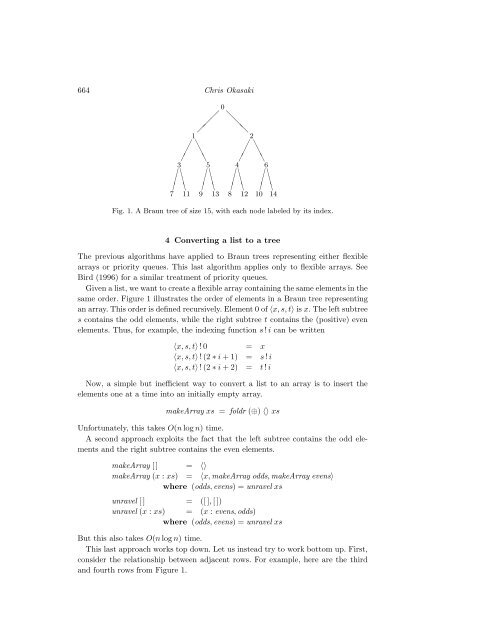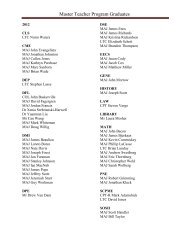FUNCTIONAL PEARLS Three Algorithms on Braun Trees - West Point
FUNCTIONAL PEARLS Three Algorithms on Braun Trees - West Point
FUNCTIONAL PEARLS Three Algorithms on Braun Trees - West Point
Create successful ePaper yourself
Turn your PDF publications into a flip-book with our unique Google optimized e-Paper software.
664 Chris Okasaki<br />
0<br />
� ❅<br />
� ❅❅<br />
�<br />
1 2<br />
✁ ❆ ✁ ❆<br />
✁ ❆❆ ✁ ❆❆<br />
✁ ✁<br />
3 5 4 6<br />
✄❈<br />
✄❈<br />
✄❈<br />
✄❈<br />
✄ ❈❈ ✄ ❈❈ ✄ ❈❈ ✄ ❈❈<br />
✄ ✄ ✄ ✄<br />
7 11 9 13 8 12 10 14<br />
Fig. 1. A <strong>Braun</strong> tree of size 15, with each node labeled by its index.<br />
4 C<strong>on</strong>verting a list to a tree<br />
The previous algorithms have applied to <strong>Braun</strong> trees representing either flexible<br />
arrays or priority queues. This last algorithm applies <strong>on</strong>ly to flexible arrays. See<br />
Bird (1996) for a similar treatment of priority queues.<br />
Givenalist,wewanttocreateaflexiblearrayc<strong>on</strong>tainingthesameelementsin the<br />
same order. Figure 1 illustrates the order of elements in a <strong>Braun</strong> tree representing<br />
an array.This orderis defined recursively.Element0of〈x,s,t〉 is x. The left subtree<br />
s c<strong>on</strong>tains the odd elements, while the right subtree t c<strong>on</strong>tains the (positive) even<br />
elements. Thus, for example, the indexing functi<strong>on</strong> s!i can be written<br />
〈x,s,t〉!0 = x<br />
〈x,s,t〉!(2∗i+1) = s!i<br />
〈x,s,t〉!(2∗i+2) = t!i<br />
Now, a simple but inefficient way to c<strong>on</strong>vert a list to an array is to insert the<br />
elements <strong>on</strong>e at a time into an initially empty array.<br />
makeArray xs = foldr (⊕) 〈〉 xs<br />
Unfortunately, this takes O(nlogn) time.<br />
A sec<strong>on</strong>d approach exploits the fact that the left subtree c<strong>on</strong>tains the odd elements<br />
and the right subtree c<strong>on</strong>tains the even elements.<br />
makeArray [] = 〈〉<br />
makeArray (x : xs) = 〈x,makeArray odds,makeArray evens〉<br />
where (odds,evens) = unravel xs<br />
unravel [] = ([],[])<br />
unravel (x : xs) = (x : evens,odds)<br />
where (odds,evens) = unravel xs<br />
But this also takes O(nlogn) time.<br />
This last approach works top down. Let us instead try to work bottom up. First,<br />
c<strong>on</strong>sider the relati<strong>on</strong>ship between adjacent rows. For example, here are the third<br />
and fourth rows from Figure 1.




